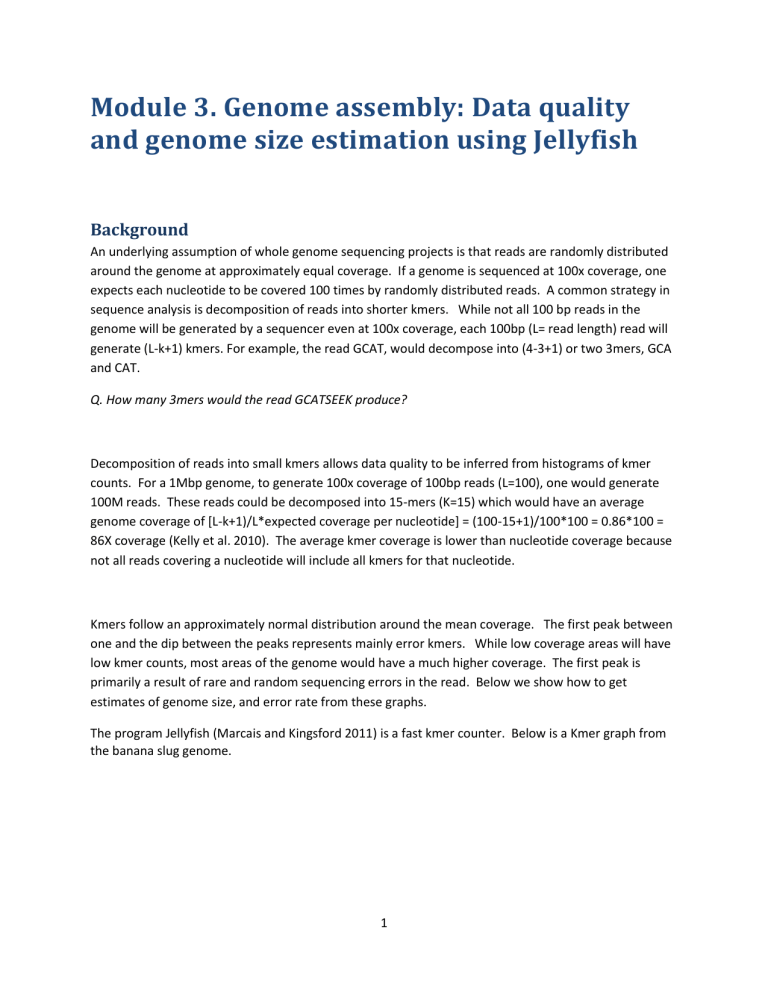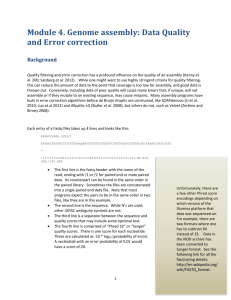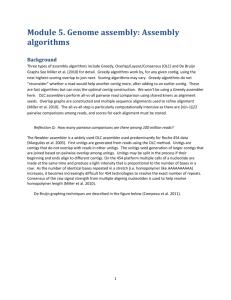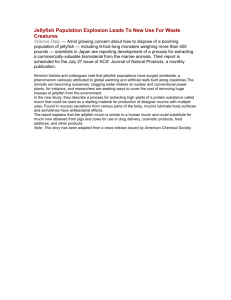Data quality and genome size estimation using Jellyfish

Module 3. Genome assembly: Data quality and genome size estimation using Jellyfish
Background
An underlying assumption of whole genome sequencing projects is that reads are randomly distributed around the genome at approximately equal coverage. If a genome is sequenced at 100x coverage, one expects each nucleotide to be covered 100 times by randomly distributed reads. A common strategy in sequence analysis is decomposition of reads into shorter kmers. While not all 100 bp reads in the genome will be generated by a sequencer even at 100x coverage, each 100bp (L= read length) read will generate (L-k+1) kmers. For example, the read GCAT, would decompose into (4-3+1) or two 3mers, GCA and CAT.
Q. How many 3mers would the read GCATSEEK produce?
Decomposition of reads into small kmers allows data quality to be inferred from histograms of kmer counts. For a 1Mbp genome, to generate 100x coverage of 100bp reads (L=100), one would generate
100M reads. These reads could be decomposed into 15-mers (K=15) which would have an average genome coverage of [L-k+1)/L*expected coverage per nucleotide] = (100-15+1)/100*100 = 0.86*100 =
86X coverage (Kelly et al. 2010). The average kmer coverage is lower than nucleotide coverage because not all reads covering a nucleotide will include all kmers for that nucleotide.
Kmers follow an approximately normal distribution around the mean coverage. The first peak between one and the dip between the peaks represents mainly error kmers. While low coverage areas will have low kmer counts, most areas of the genome would have a much higher coverage. The first peak is primarily a result of rare and random sequencing errors in the read. Below we show how to get estimates of genome size, and error rate from these graphs.
The program Jellyfish (Marcais and Kingsford 2011) is a fast kmer counter. Below is a Kmer graph from the banana slug genome.
1
F IGURE 1.
K MER GRAPH FROM BANAN A SLUG GENOME .
H ISTOGRAMS FROM A VAR IETY OF KMERS ARE SH OWN , AS WELL AS A FIT OF
THE MAIN KMER PEAK F OR 15 MERS ACCORDING TO A GAMMA DISTRIBUTION .
F ROM : HTTPS :// BANANA -
SLUG .
SOE .
UCSC .
EDU / BIOINFORMATIC _ TOOLS : JELLYFISH ) .
These graphs show multiplicity of a kmer (how many times is a kmer found in the read data), against number of distinct k-mer with the given multiplicity.
Manual Exercise: Make your own kmer histogram and estimate genome size by hand
Given the following reads {GCA, CAT, ATG, TGC}:
Make a kmer histogram based on the distribution of 2-mers from these reads, and estimate mean multiplicity.
Estimate genome size by summing the number of distinct kmers excluding error kmers (assume no errors occurred).
2
Estimate genome size from the total number of non-error 2mers divided by mean 2mer coverage.
Suppose there was an error in one of the reads (the shaded G in the kmer shown below) such that the read set was GGA, CAT, ATG, TGC. How many unique error kmers are created from the read with the error?
Errors cause many kmers to be affected, and cause a low frequency bump in kmer histograms with high genome coverage. For genomes, the shape of the kmer graph is fairly similar for kmers 15 or larger.
Below that size many kmers are repeated many times throughout the genome. At 15 and larger there are two characteristic peaks as described above for errors and true coverage. Note that repetitive DNA will have higher coverage and causes a “heavy tail” for the main peak.
Goals
Practice using the Linux Operating System
Remote Cluster Computing
Run an application in Linux
Estimate genome size
Estimate data error rate
Develop and interpret Kmer graphs
V&C Competencies addressed
Ability to apply the process of science: Evaluation of experimental evidence
Ability to use quantitative reasoning: Developing and interpreting graphs, Applying statistical methods to diverse data, Managing and analyzing large data sets
Use modeling and simulation to understand complex biological systems: Applying informatics tools, managing and analyzing large data sets
GCAT-SEEK sequencing requirements
Any
Computer/program requirements for data analysis
Linux OS, Jellyfish
Optional Cluster: Qsub
If starting from Window OS: Putty
If starting from Mac or Linux OS: SSH
3
Protocols
Log into the HHMI cluster as you did above in Module 2.
Configuring your bashrc file
To use the programs that are installed on our cluster, you first need to set your PATH variable which tells the computer where to look for programs.
To configure your .bashrc file with the path to the programs, copy the “.bashrc” file from sickler’s home directory (~sickler), paste it over yours, and activate it using the following commands:
$sudo cp ~sickler/.bashrc ./.bashrc
$source .bashrc
Note that the “.” before the file name will hide the directory, but hidden files can be seen in your home directory using the “$ls –la” command. Hidden files can be edited using $nano and viewed using $less.
The sudo will override the cluster’s unhappiness with you copying something from someone else’ directory.
To verify everything worked enter:
$which nseg the computer should return:
/share/apps/nseg/nseg
Use the cluster to run jellyfish
A.
Log onto the cluster.
B.
Make a directory entitled, jellyfish
$mkdir jellyfish
C.
Copy the raw fastq files for S. aureus from Buonaccorsi’s home directory into your jellyfish directory. After the first file transfers, check it by ls. Then use the up arrow key to recall the sudo operation and change the 1 to 2.
$sudo cp ~buonaccorsi/*1.fastq .
$ls
$sudo cp ~buonaccorsi/*2.fastq .
$ls
D.
Move the files into jellyfish and then move into jellyfish as your working directory
$mv *.fastq jellyfish
4
$cd jellyfish
E.
Concatenate all fastq files into a single file called, “input.fasta”
$cat *.fastq > input.fastq
F.
First we will run the Jellyfish program on two processors using the head node of the cluster to count kmers and then see how much faster it is to distribute the job to 16 worker nodes. Time how long the job takes with 2 processors here compared to 16 in step G.
$jellyfish count – m 15 –o output –c 3 –s 20M –t 2 input.fastq
(-m 15 sets the size of kmers counted to 15, -o sets the prefix of output files, -c sets the number of bits to use for counting kmers in a single row, -s sets the size of the Hash table used to store and count kmers(20M = 20 million), -t sets the number of threads (processors) the job is divided into, NOTE: -h or --usage after the command will explain the options available with most programs!!)
We will be using Qsub to submit jobs to the cluster queue.
Copy ExampleQsubScript from the Buonaccorsi home page.
$sudo cp ~buonaccorsi/ExampleQsubScript .
Edit the file ExampleQsubScript as follows:
#!/bin/bash
#PBS -k o
#PBS -l nodes=1:ppn=16
#PBS -N [Name Of Job]
#PBS -j oe
#================================================#
# [NameOfJob.dat] CONFIG #
#================================================#
# NODES AND PPN MUST MATCH ABOVE #
NODES=1
PPN=16
JOBSIZE=10000 workdir=/home/[your user name]/jellyfish cd $workdir jellyfish count – m 15 –o output –c 3 –s 20M –t 16 input.fastq
______________________________________________________________
5
G.
Send the job to the worker nodes by entering:
$qsub -p [an integer between -1024 and 1023 with higher values as priority] [name of script] e.g. $qsub –p 100 ExampleQsubScript
H. To shows full listing of processes running in Qsub:
$qstat -all
I. To delete your job if you make a mistake:
$qdel [jobid]
J. Merge hash tables using the regular expression\_*. “\_* will find the _ character and anything after it to merge into the output.jf file. Small jobs like this can be done with the head node.
$jellyfish merge –o output.jf output\_*
K.
Check the results using:
$ls
L.
Make a histogram of the Kmer counts. “-f” will include kmers with count zero (should be empty for Kmers, but wouldn’t be for qmers from Quake). “>” will send the results to a file named
“histogram.txt.” Always be careful using “>”.
$jellyfish histo –f output.jf > histogram.txt
M.
Check the histogram using $less . It should include two columns, with the first the multiplicity
(X axis) and count (Y axis).
$less histogram.txt
N.
Calculate stats on the qmers for estimate of error rate and genome size into a file called
“stats.txt, ” and open it up.
$jellyfish stats –v –o stats.txt output.jf
$less stats.txt
O.
Note that “unique” kmers are those represented only once in the data. “Distinct” kmers refers to the number of kmers not including their multiplicity (i.e. not summing across how many times they are found; i.e. how many kmers with different sequences were found including unique and non-unique kmers). Total kmers refers to the number of distinct kmers including their multiplicity [i.e. sum of (the number of kmers found at each multiplicity * their multiplicity)].
6
So if there were 100 unique kmers, 30 found 2X, 40 found 3X, and 30 for 4X, the number of distinct kmers would be 200, the number of unique kmers is 100, the maximum number
(max_count) of kmers is 100, and total number of kmers is 400.
Assessment
1.
Record frequency of the first 10 multiplicities below from the histogram file.
Multiplicity
1
7
8
9
4
5
2
3
6
10
Frequency
2.
Counts typically start high indicating errors, dip, and then increase to designate true coverage, with a peak at the average kmer coverage. Identify the low point of the dip.
3.
Take the sum of the kmers with multiplicities below the minimum above:__________. These represent mainly error reads.
4.
What was the number of distinct kmers:________
5.
Subtract number of distinct error kmers from total number of distinct kmers:_______________.
This is an estimate of genome size.
6.
Divide total number of error kmers by total number of kmers x 100. This is the percent of error
kmers. Divide further by kmer size to get an estimate of per bp error rate:__________
7.
What is the total number of kmers:______________
8.
At what multiplicity is the second kmer peak?____________. This is an estimate of average
kmer coverage.
9.
Divide total # good kmers by average kmer coverage to get another estimate of total genome
size:____________
Time line of module
One to two hours of lab
Discussion topics for class
Question: How close are your two estimates of genome size? Why might they differ?
7
Background lecture topics could include basic Linux, genome structure and content, next generation sequencing, genome sequencing strategies, and cited literature.
References
Literature Cited
Kenney DR, Schatz MC, Salzberg SL. 2010. Quake:quality-aware detection and correction of sequencing errors. Genome Biology 11:R116
Marcais G, Kingsford C. 2011. A fast, lock-free approach for efficient parallel counting of occurrences of k-mers. Bioinformatics. 27:764-770. [Jellyfish program]
8








